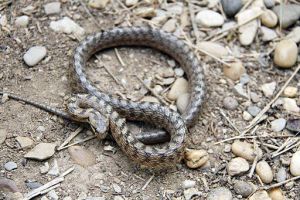Reptile

The name reptiles (from the Latin reptile, "creeping ") refers to terrestrial animals with variable temperatures (ectotherms), whose bodies are often elongated and covered in scales, and whose gait, with legs spread out and body close to the ground, is close to creeping. This group, which sources prior to the 21st century consider to be a taxon called Reptilia, includes extinct animals such as dinosaurs, ichthyosaurs, plesiosaurs, pliosaurs and pterosaurs. Since the rise of cladistics and especially cladism, a growing number of researchers consider that the word reptile should no longer be used as a valid taxon, as it does not designate a holophyletic group whose species all descend from an exclusive common ancestor " reptilian ", but form a paraphyletic grouping of species similar in terms of ectothermy and scales. The " reptiles " group would thus be paraphyletic because the group's common ancestors also produced offspring that did not possess such characteristics. These are mammals and birds.
These researchers claim that today's reptiles, crocodilians, turtles, rhynchocephalans and squamates belong to lineages that are less related to each other than to other lineages that are not " reptilian ", such as birds : crocodilians, for example, are closer to birds than to lizards or turtles. What's more, some fossil groups that were once considered to be " reptiles " possess characteristics that are not found in today's reptiles : ichthyosaurs were found to have been viviparous ; others, such as the pterosaurs, were hairy; and finally, the dinosaurs revealed among them forms that maintained a constant temperature (homeotherms), including the theropods, which gave rise to birds.
This is why, in the West, since the 1980s, the grouping of reptiles as a taxon has been abandoned by cladist scientists, who are now in the majority, and in French primary and secondary education. On the other hand, it is still widely used in everyday language, in scientific institutions in other countries (notably China, Spanish-speaking and Russian-speaking countries), and it is still formally recognised as a class in evolutionary systematics, a school of taxonomy that is still active,,.
The Reptilia class comprises four orders of contemporary species :
crocodilians : 30 species of crocodiles, gavials, caimans and alligators ;
Rhynchocephalans : 1 species of sphenodon ;
squamates : around 10,000 species of lizards (in the broadest sense), snakes and amphisbenes ( lézard-ver ) ;
turtles : around 340 species. The study of these animals forms one of the two branches of herpetology, the other being the study of amphibians, formerly grouped with reptiles.
The first animals in this class appeared on Earth in the Carboniferous period, at the same time as the amniotes. The first vertebrates to colonise the terrestrial environment, they rapidly diversified into numerous species. Reptiles are now well represented, with more than 9,000 species recorded in 2011, mainly located near the tropics, but the traditional view that the Mesozoic was a " age of reptiles " followed by a " age of mammals " has been abandoned, and it is now considered that a " age of dinosaurs and mammals " began in the Triassic and continues to the present day (since birds are dinosaurs), while the real " age of reptiles " took place before that, in the Permian, before fading away in the Triassic.
Reptiles have always intrigued or fascinated humans. Because some are capable of devouring humans (crocodilians, large monitor lizards) or have potentially lethal venoms, reptiles sometimes frighten people, sometimes arouse phobias, but at other times they are sacred and the object of complex symbolism. They are omnipresent in mythologies the world over and have inspired the human imagination, serving as models for dragons, for example. Others arouse sympathy, such as the turtles that, in some myths, carry the world on their backs.
In recent years, reptile farming has expanded worldwide, to supply the meat market in certain consumer countries, but above all the luxury leather goods market, which uses their skins, and the market for new pets. However, poaching is also widespread, endangering many species despite international attempts to regulate the wildlife trade. Pollution and the disappearance of reptile habitats are the other main dangers facing reptiles.()